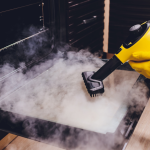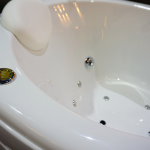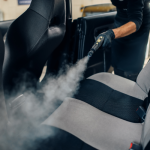Coffee makers are irreplaceable heroes of the kitchen as they provide us with the best coffee every day. However, moisture in the kitchen does not favor them. Your coffee maker may have molds. Moreover, minerals accumulate in coffee makers. The main components of water are calcium, magnesium, and sodium. The mineral residue that forms can damage the coffee maker. Check out how, in a few simple steps, to prevent such a situation.
Why do coffee makers require cleaning?
If you do not regularly clean the brewing basket and other elements, you may notice that the residue makes your coffee increasingly bitter. In addition, the humid environment of the remaining coffee grounds may promote the growth of bacteria, yeasts, and molds.
In this guide, we will show you how to clean a coffee maker and restore it to perfect condition using a steam cleaner.
How to clean a coffee maker to make your morning coffee taste better?
Your coffee maker or coffee jug may appear clean. However, oils and minerals accumulate in the coffee maker and jugs, leaving dirt that is not visible at first glance. However, unseen bacteria and germs can cause more serious problems.
Plan to clean your coffee maker once a month if you use it daily. Cleaning every three to six months may be sufficient for occasional coffee consumers. However, you should clean the coffee maker if you notice a clear accumulation of scale around the jug or basket, or if your coffee tastes odd. Before you start the cleaning process, make sure there are no coffee residues in the coffee maker.
What you need:
- distilled white vinegar
- water
- a lint-free cloth
- a paper filter
Step 1: Fill the coffee maker with vinegar and water
Fill the coffee maker tank with a 50-50 solution of distilled white vinegar and water to start cleaning it. If your coffee maker has a particularly strong residue, you can increase the ratio of vinegar to water. Vinegar, besides cleaning the coffee maker and jug, also dissolves accumulated mineral deposits.
Step 2: Run the brewing cycle
After inserting the filter into the brewing basket, start the coffee maker. Turn off the coffee machine halfway through brewing and, depending on the amount of residue to be removed, let the remaining vinegar solution soak in the jug and tank for 30 to 60 minutes.
Step 3: Cleaning the filter basket
Place the coffee filter basket in soapy water. Let it soak if coffee grounds are still present. Gently scrub the filter with a kitchen sponge, trying to reach all corners.
Step 4: Complete the cycle and rinse
Restart the coffee maker and let it finish the brewing process. After discarding the paper filter, if any remains, pour out the vinegar solution.
Now you can remove the taste and smell of vinegar from the coffee maker. Insert a filter into the basket, add new water to the tank, start the coffee maker, and let it finish the brewing process. The filter should be removed, the water emptied, and a new cycle started with fresh water. Use a clean cloth to clean the coffee maker and coffee jug.
How to clean a drip coffee maker
Step 1: Remove the brewing basket and filter
After removing the brewing basket, discard the grounds and any disposable paper filters. Also remove any permanent filters.
Step 2: Solution
Pour warm water into the sink or a large container.
Add dish soap to the water. It is best to use a brand designed to remove grease.
Step 3: Cleaning the coffee maker
To the warm soapy water, add the brewing basket and the permanent filter (if you have one). Thoroughly remove coffee grounds and oily residues, washing them with a gentle cloth or sponge.
Step 4: Cleaning the jug
Discard any remaining coffee and rinse the jug with warm water. After adding a small amount of soapy water, thoroughly clean the jug using a soft cloth or sponge.
Step 5: Rinse
Use warm water to rinse the jug, the permanent filter, and the brewing basket. After wiping with a dry cloth, place them on a dish rack.
Step 6: Inspection
To clean any remaining residues, wipe the inner lid of the coffee maker, the outer lid, and the brewing area with a soft cloth soaked in soapy water. Then, dampen a lint-free cloth with clean water to remove remaining soap.
How to clean a Keurig coffee maker
A Keurig coffee maker is somewhat different in shape than a regular coffee jug.
What you need:
- dish soap
- a toothbrush
- a lint-free cloth
- water
- white vinegar
Step 1: Wash the exterior of the Keurig coffee maker
Fill the coffee maker tank with a vinegar solution (mix vinegar and water in equal parts) to start cleaning it. If your coffee maker has a particularly strong residue, you can increase the ratio of vinegar to water. Vinegar, in addition to cleaning the coffee maker and jug, also destroys accumulated mineral deposits.
Step 2: Clean the interior of the coffee maker
Use a clean toothbrush to gently clean coffee grounds that may have gotten stuck in the K-Cup capsule holder, while removable parts are being washed or soaked. Use a damp cloth to clean any lingering dirt. Finally, wipe the outside with a cloth soaked in a universal cleaner.
If you notice scale forming (white, brittle deposits), simply apply some white vinegar to part of the cloth, place it on the problem area, and leave it for a few minutes. The white spots should disappear if you wipe again. The last step will be to assemble the Keurig coffee maker.
Step 3: Cleaning with vinegar solution
Before you start cleaning, make sure there are no capsules in the Keurig coffee maker. Place a large empty cup on the tray. Remove the water filter, if any, and empty the tank of remaining water. Fill the tank to the brim with a mixture of distilled vinegar and water in equal proportions. Turn on the Keurig, select the largest cup size, and run the vinegar mixture through the device as many times as necessary for the “More/Add Water” light to appear. After each brew, empty the hot liquid from the cup into the sink.
Step 4: Let the solution stand and rinse the water tank
Leave the Keurig coffee maker for at least 30 minutes. After the allotted time has passed, remove the tank and rinse it under water to remove the remaining vinegar. Further rinses may be necessary.
Step 5: Conduct a brewing cycle
To remove vinegar from the device, repeat Step 3, but this time only use clean water. Place another empty cup on the tray. Fill the tank with water up to the brim. Use the largest cup size and run water through the machine until the tank is empty. Your freshly cleaned Keurig machine is now ready for the next morning brew!
Cleaning your coffee machine with a Fortador Volt Mini steamer
Steamers have become the preferred method for cleaning and disinfecting a variety of objects, including all sorts of vehicles, as well as homes, workplaces, medical facilities, and many different types of commercial organizations.
Eco Method
Steam cleaning is environmentally friendly as it allows for cleaning and refreshing various surfaces with little or no additional detergent or other agents. The main advantage of steaming is the ability to eliminate and kill over 99% of bacteria, viruses, germs, and other pathogens. For many different cleaning tasks, however, using a large diesel-powered steamer is not feasible. The Fortador Volt Mini steamer comes to the rescue.
The Fortador steamer is capable of cleaning kitchen appliances, including coffee machines. Steaming the outside of a “drip” coffee maker kills bacteria.
Tips to keep your coffee maker clean for longer
- Coffee should be brewed using demineralized water.
- If you fill the water tank with a jug, only do so when you wash it after each use with warm, soapy water.
- Never store damp coffee grounds in the coffee maker for a long time.
Your coffee maker will operate correctly and last longer with regular maintenance
Scaling can build up faster if you have hard water (water with a high mineral content) in your home, or if you frequently fill the coffee maker’s water tank from a jug that is only rinsed, not thoroughly cleaned. In such a situation, monthly cleaning is recommended.
Some coffee makers have a cleaning indicator that is audible or visible, and usually appears before forced downtime. Proactive maintenance can reduce downtime. Other coffee makers have a setting for a cleaning cycle, which is often described in the instructions. Always follow the cleaning guidelines provided by the manufacturer.




